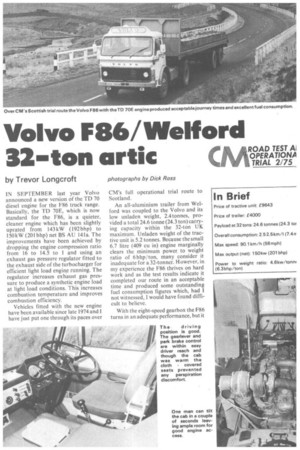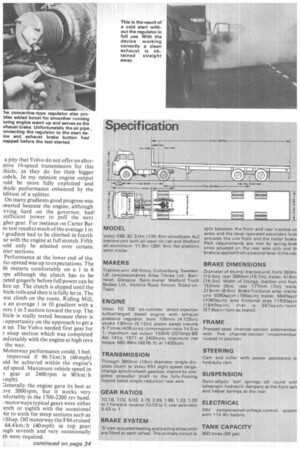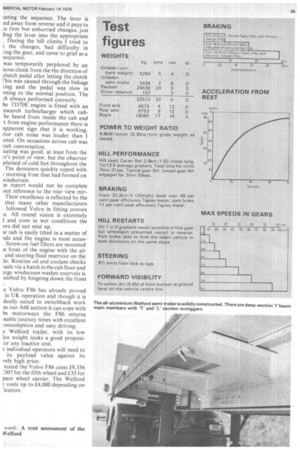Volvo F86/Welford 32-ton artic C
Page 34

Page 35

Page 36

Page 37

If you've noticed an error in this article please click here to report it so we can fix it.
by Trevor Longcroft
photographs by Dick Ross IN SEPTEMBER last year Volvo announced a new version of the TD 70 diesel engine for the F86 truck range. Basically, the TD 70E, which is now standard for the F86, is a quieter, cleaner engine which has been slightly uprated from 143 kW (192 bhp) to 150 kW (201 bhp) net BS AU 141a. The improvements have been achieved by dropping the engine compression ratio from 16 to 14.5 to 1 and using an exhaust gas pressure regulator fitted to the exhaust side of the turbocharger for efficient light load engine running. The regulator increases exhaust gas pressure to produce a synthetic engine load at light load conditions. This increases combustion temperature and improves combustion efficiency.
Vehicles fitted with the new engine have been available since late 1974 and I have just put one through its paces over CM's full operational trial route to Scotland.
An all-aluminium trailer from Welford was coupled to the Volvo and its low unladen weight, 2.4 tonnes, provided a total 24.6 tonne (24.3 ton) carrying capacity within the 32-ton UK maximum. Unladen weight of the tractive unit is 5.2 tonnes. Because the small 6.7 litre (409 cu in) engine marginally clears the minimum power to weight ratio of 6 bhp /ton, many consider it inadequate for a 32-tonner. However, in my experience the F86 thrives on hard work and as the test results indicate it completed our route in an acceptable time and produced some outstanding fuel consumption figures which, had 1 not witnessed, I would have found difficult to believe.
With the eight-speed gearbox the F86 turns in an adequate performance, but it a pity that Volvo do not offer an alterative 16-speed transmission for this .thicle, as they do for their bigger lodels. In my opinion engine output )uld be more fully exploited and hicle performance enhanced by the idition of a splitter.
On many gradients good progress was 'warted because the engine, although living hard on the governor, hadi sufficient power to pull the next gher gear. For instance on Carter Bar ee test results) much of the average 1 in I gradient had to be climbed in fourth ar with the engine at full stretch. Fifth luld only be selected over certain ater sections.
Performance at the lower end of the tio spread was up to expectations. The 36 restarts comfortably on a 1 in 6 3pe although the clutch has to be ated gingerly before full power can be ken up. The clutch is slipped until the hide rolls and then it is fully let in, The )rst climb on the route, Riding Mill, .s an average I in 10 gradient with a vere 1 in 5 section toward the top. The hick is really tested because there is 'opportunity on the approach to get a n up. The Volvo needed first gear for steep section which was completed mfortably with the engine at high revs the way.
Motorway performance could, I feel, improved if 96.5 km/ h (60 mph) uld be achieved within the engine's ed speed. Maximum vehicle speed in ) gear at 2400 rpm is 90 km/ h mph).
;_lenerally the engine gave its best at aye 2000 rpm, but it works very nfortably in the 1700-2200 rev band. motorways typical gears were either .enth or eighth with the occasional tie to sixth for steep sections such as Shap. Off motorway the F86 cruised 64.4 km/ h (40mph) in top gear; vugh seventh and very occasionally. th were required.
Even though the engine was pushed hard all round the circuit the F86 produced a highly respectable fuel consumption. The 2.5km/1 (7.4 mpg) overall consumption is well over the 2.3 km/ I (6.5 mpg) which is about par for the course. Apart from two, the individual section consumptions are consistent, but the two higher figures look unbelievably good especially as one covers the hilly M6 Shap section. The air filter condition indicator showed red a replacement or filter clean was due; which makes the fuel consumption even more exceptional. Under normal engine conditions tt exhaust regulator functions automati ally. However there is a manual operated air-actuated boost fi improved light-load engine running ju after firing a cold engine. Because t air-feed pipe to the regulator had fra tured before the test started; the co start device was inoperative. The pipe rigidly mounted between the engine at the back end of the turbocharger; is apparent that a flexible pipe will needed to reduce pipe stressing as t engine and turbocharger flex duril vehicle operation.
The boost was badly missed during cold early morning start in Scotian After a frosty night the engine fir readily with the excess fuel devi engaged but it was a few minutes befc a clean exhaust was obtained. I ha seen similar starts with the dev operative and can report that it wor very well.
The regulator also doubles as I exhaust brake but because the pipe h fractured, the floor-mounted exha brake button in the cab was redunda The exhaust brake was missed on hilly A68 section of the route, when c tinual use of the brakes produce, strong smell from the linings. How( brake performance did not suffer E consequence.
During the brake tests at the MI proving grounds the park br returned a poor II per cent maxim efficiency in stopping the vehicle ft 32.2 km/ h (20mph). But it held vehicle on a 1 in 6 gradient mee the legal requirement. The second brake returned 48 per cent peak ef ency from the same speed.
A surprising feature of the test was tendency for the cab to nod w passing over bumps or uneven stret( of road. On two occasions at 1 motorway speeds this nod seemed tc the front axle to such an extent steering became vague and I had slightly reduce speed to regain full ( trol. The most likely cause is that t was insufficient weight on the front It was loaded to 5.3 tonnes (5.2 to Steering is power assisted hydraulic ram and, in my view, thi not as precise and light as the inte power systems fitted to the he Volvos and other marques.
Apart from the haulage aspect F86 is so easy to drive that it cc double as the ideal training vehicle. driving controls are well placed for driver and I particularly liked positioning of the gear lever close tc driver's thigh.
The synchromesh gearbox is eas: use; it has a conventional four-sr gate, the range change being selected in fourth before returning lever to the first/ fifth position :ating the sequence. The lever is )ed away from reverse and it pays to ce firm but unhurried changes, just ling the leNer into the appropriate . During the hill climbs I tried to the changes, had difficulty in :ing the gear, and came to grief as a sequence.
was temporarily perplexed by an nous clonk from the the direction of clutch pedal after letting the clutch ['his was caused through the linkage cing and the pedal was slow in rning to the normal position. The :)h always performed correctly.
he TD7OE engine is fitted with an esearch turbocharger which can be heard from inside the cab and .t from engine performance there is apparent sign that it is working.
nor cab noise was louder than I )cted. On occasions across cab was cult conversation.
eating was good, at least from the cr's point of view, but the observer plained of cold feet throughout the The demisters quickly coped with morning frost that had formed on Nindscreen.
le report would not be complete out reference to the rear view mirTheir excellence is reflected by the that many other manufacturers • followed Volvo in fitting convex s. All round vision is extremely I and even in wet conditions the ors did not mist up.
ie cab is easily tilted in a matter of ads and the engine is most acces. Screw-on fuel filters are mounted le front of the engine with the air and steering fluid reservoir on the Je. Routine oil and coolant checks lade via a hatch in the cab floor and a rge windscreen washer reservoir is • nished by hingeing down the front e Volvo F86 has already proved in UK operation and though it is deally suited to switchback work as our A68 section it can cope with 1n motorways the F86 returns )nable journey times with excellent :onsumption and easy driving.
e Welford trailer, with its low len weight looks a good proposi'or any tractive unit.
t individual operators will need to its payload value against its vely high price: tested the Volvo F86 costs £9,336 307 for the fifth wheel and E33 for pare wheel carrier. The Welford r costs up to £4,000 depending on ication.




































































































